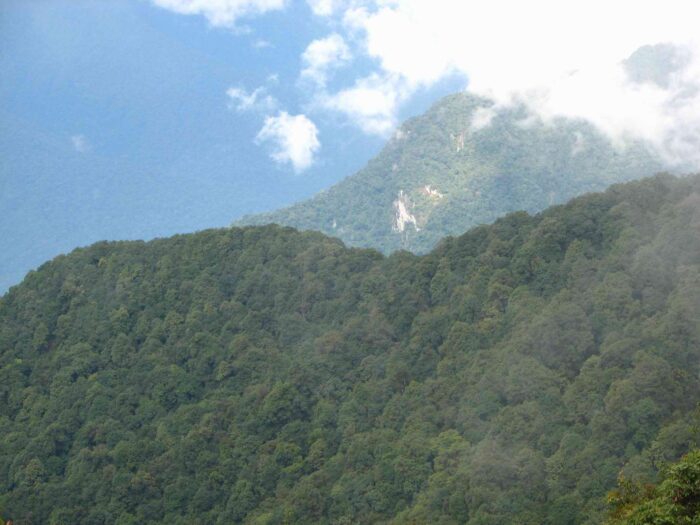
The Ithun river, a tributary of the Dibang. Photo : Raju Mimi
The Forest Advisory Committee (FAC) of the Ministry of Environment, Forest and Climate Change (MoEF&CC) headed by the Director General of Forest during its meeting of 23rd of April has sought the opinion of the NTCA and Ministry of Power before taking a final decision on the proposal for diversion of 1,165.66 hectares of forest land for the construction of Etalin Hydroelectric Project (HEP) in Arunachal Pradesh’s Dibang Valley district. The minutes were made public on the 11th of May by the environment ministry on its website.
The FAC demanded views from the Power Ministry on whether its wants to pursue the project in its present form. The FAC recorded that the project has already been delayed by 6 years and that the energy plan may have been changed during this period. It also observed that large number of hydro-electric projects are pending for environment/forest clearance and therefore, priority may be given to reducing cumulative impact. The minutes also highlight that tariff structure of the project was already high at the time of proposal i.e. 2015.
The FAC also directed the State Government to submit the cost-benefit analysis as per the latest Ministry Guidelines. The minute’s record that 230 bird species have been identified from the area and the State Government will review if the trees marked for felling (at least in the reservoir area) could be left as such. Considering that Etalin is a large project proposed in the Himalayas, FAC demanded views of the IA division of the Ministry on the environmental impact of the project and mitigation measures. Given that the latest biodiversity impact assessment by the Wildlife India Institute (WII), Dehradun did not establish the presence of tigers in the region, the FAC directed comments of the Wildlife Division of the Ministry and NTCA.
It is important to note that a lot of conservationists had raised objection to the project but the FAC casually remarked that “all these representations are similar or same in content. These are general in nature and no detailed scientific, economic or sociological evidence was provided for specific analysis/deliberation.”
Background of the Etalin HEP
The Etalin HEP is proposed in the Anini Forest Division and will divert forest land supports 0.6 canopy density. The number of trees to be felled has been estimated as 3, 02, 538 trees . The project will be developed in joint venture between Hydropower Development Corporation for Arunachal Pradesh and Jindal Power Limited. The Etalin HEP is proposed to be developed as a combination of two run-of-the river schemes having diurnal storage. The project envisages construction of concrete gravity dams on Dri river (101.5 m) and Tangon river (80 m). The water will be diverted through two separate waterways systems to utilize the available head in a common underground powerhouse located just upstream of the confluence of Dri and Tangon rivers. The total installed capacity of the project is 3,097 MW.
Etalin HEP: Considered by FAC multiple times
The project was considered was considered by the FAC in its meeting dated 28.01.2015 where FAC deferred the project till the completion of the Cumulative Environment Impact Assessment and Carrying Capacity Study of Dibang River Basin. The study observed that both Dibang MPP and Etalin HEP have made substantial progress in terms of survey and investigation and preparation and EIA study reports. The study recommended that no changes are required for these projects. The project was then considered by FAC in its meeting dated 28.02.2107 wherein it observed that the project falls under the richest richest bio-geographical province of the Himalayan zone and falls under one of the mega bio-diversity hotspots of the world. As per IUCN Management categories, the project falls under Endemic Bird Area, Global Biodiversity Hotspot and Key Biodiversity Area indicting its importance at global scale. Presence of tigers and snow leopards have also been recorded from the area. The FAC therefore recommended conducting multiple seasonal replicate studies on biodiversity impact assessment by an internationally credible institute as the EIA is completely inadequate in this regard. The FAC also directed that views of NTCA be taken. The project was then deliberated upon by the FAC in its meeting dated 17.10.2019 wherein it decided to constitute a sub-committee for a site visit to assess the following: possibility for reduction in land requirement, tree enumeration and multiple seasonal replicate biodiversity assessment by WII. The FAC reiterated that views of NTCA be submitted.

Dibang Valley forests : The Dibang and Lohit valleys contain some of the last large contiguous tracts of tropical, subtropical and temperate forests in the country, rich in wildlife. These will be seriously fragmented by multiple proposed large hydropower projects.
Views of the FAC Sub-Committee
The sub-committee of the FAC recommended a reduction of 15.58 hectares of forest land proposed handing over an area of 424.83 hectares to the Forest Department after the commissioning of the project. The sub-committee revised the estimated number of trees to be felled from 2,80,681 trees to 3,02,538 trees. The WII biodiversity assessment based on replicate seasonal assessments recorded 413 plant species, 159 species of butterflies, 113 species of spiders, 11 species of ordorates, 14 species of amphibians, 31 species of reptiles, 230 bird species and 21 mammalian species within the zone of influence of the HEP. The WII study did not establish the presence of tigers in the region. To mitigate the loss of habitat of identified floral and faunal groups, the WII recommended 3 action plans: Mitigation Plan, Biodiversity Conservation Plan, and Action Plan for enhancement of bio-resources for people. The WII study was accepted by the sub-committee on the condition that the user agency will fund the conservation plans. The FAC in its meeting dated 23.04.2020 accepted the recommendation of its sub-committee.
The FAC highlighted that proposal is a run-of-the-river project with potentially lesser submergence area. It further accepted the biodiversity assessment study conducted by WII and the mitigation plan proposed by them. The FAC recommended that the mitigation plan will be implemented fully and in time. The FAC will now consider the proposal for construction of Etalin based on the comments from Ministry of Power and NTCA.
(Mridhu Tandon is a associate analyst with Legal Initiative for Forest and Environment, New Delhi. mridhu@lifeindia.net.in)
[the_ad id=”22718″]


















